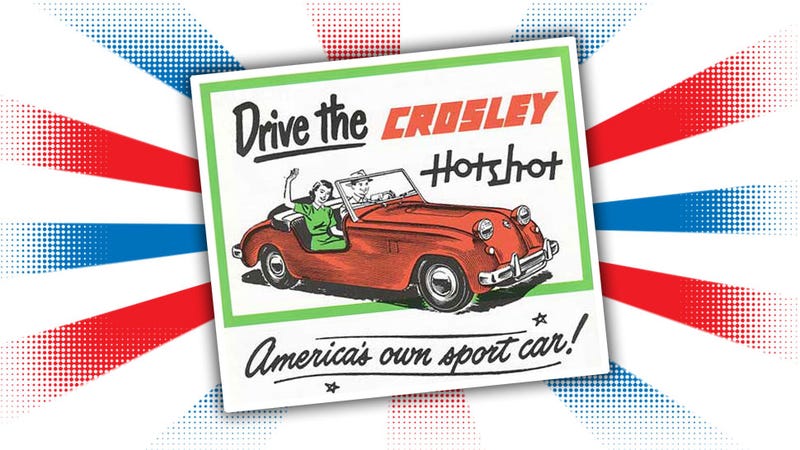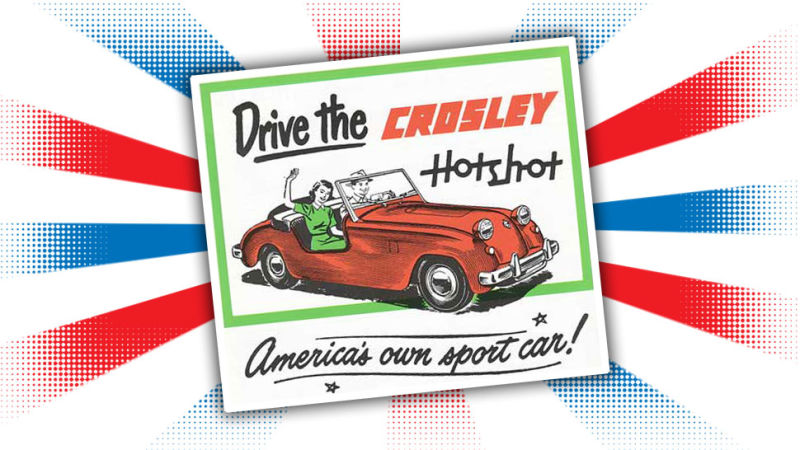
I decided to take a little break from my annual Fourth of July marathon lovemaking session with a very special and majestic bald eagle to talk to you about an American car that I think deserves more attention than it gets: the Crosley Hotshot. The humble little Hotshot helped define a sportscar formula that still works today.
This post originally ran on July 4, 2015, and is being re-shared for the Fourth of July weekend.
Crosley was a company ahead of their time. Before the coming of imports like the VW Beetle or, later, the Honda Civic, if you wanted a small, cheap, fuel efficient, useful little car in the US, Crosley was about your only choice. Originally a maker of radios and refrigerators, Crosely got into the car business from 1939-1952 with the goal of making ‘second’ cars for people.
Advertisement
During WWII, Crosleys became more popular because of gasoline rationing, and Crosleys were the last cars to remain in civilian production during the war. After the war, Crosleys came back with an experimental sheet-metal engine called the CoBra (for Copper Brazed) that proved to be something of an unreliable mess — a switch to a more conventional cast-iron block came soon after.
In 1949, Crosley made some history by introducing America’s first postwar sportscar, the Hotshot. Some claim it’s America’s first true sportscar, period, but I think cars like the Stutz Bearcat from the ‘20s make this claim unlikely. Even so, it was a very influential and important car, one that helped define one of the most loved types of sportscars that today we tend to associate with Lotus and Mazda.
Sponsored
Having only a 724 cc making a decimal-place-relevant 26.5 HP, the Hotshot managed to get engaging performance and some actual driving fun the only way possible — by getting rid of everything else. The car was tiny and light — only around 1100 lbs — and dirt cheap, too at $849. That was cheap as hell for a car back then, too. That would be just over $8,000 today, which is, again, dirt cheap for a car.
The Hotshot was a true roadster, doorless, and with a top that you pretty much had to assemble from Tinkertoys whenever you put it up. A later version, the Super Sport, did eventually offer such decadent trappings as a more conventional convertible top and even some doors, if you were a king or emperor or something. In fundamental design concept — the roadster design, the simple, clean, bar-of-soap body — the Hotshot looked and felt like an early lightness-added Lotus or a Mazda Miata or a Bugeye Sprite, and it’s very easy to see the Hotshot as the ancestor of all those wheeled fun machines.
The Hotshot was very simple, even crude in some of its design (suspension, we’re staring at you), but it had a few advanced features you wouldn’t expect: the first caliper-operated disc brakes on a production car (they worked great, but road grit and grime would seize them), and an overhead cam engine that would rev to nearly 10,000 RPM. It wasn’t quick by modern standards, but it was spunky enough for the era, getting to 60 in 20 seconds and maxing out at 77 MPH.
If those numbers don’t enturgitate you at all, you’ll be happy to know that the Hotshot may have also been America’s first real tuner car since the Model T, with companies offering all kinds of bolt-on go-faster toys:
Advertisement
Braje, for instance, listed a full-race cam for $25, headers for $28, and dual manifolds with Amal motorcycle carburetors for $60. Vertex and H&C sold high-performance ignition systems, and S.CO.T offered a Roots-type supercharger that more than doubled horsepower. Happily, the CIBA engine was well up to such muscle-building.
Incredibly, the tiny and cheap Hotshot had some real competition successes — in 1950 it won, outright, America’s first endurance race, the Sebring Grand Prix of Endurance, averaging an eye-melting 52 MPH. It was able to beat much larger, expensive, and faster cars thanks to the Index of Performance handicapping system that the race used, but hey, a win’s a win.
Little Crosley Hotshots actually did quite well in racing events all over the country. Here, I’ll let our pals at Hemmingsexplain:
Crosley Hotshot and Super Sports models quickly proved themselves in competition, and a Hotshot took the overall win at the inaugural Sam Collier Memorial Endurance Race in Sebring, Florida, in 1950. This was backed up by a victory in the Grand de la Suisse in 1951, along with a second-place finish in the 1951 Tokyo Grand Prix. A Hotshot entered by a privateer team of Americans may have realized an index of performance win at the 1951 24 Hours of Le Mans, but the car was forced out late in the race with a failed voltage regulator. Even at the club racing level, Crosley Hotshots became the car to have if you wanted to win races in SCCA competition, and Crosley-powered sports racers continued to be competitive long after the Hotshot faded from the scene.
That’s an absolutely respectable record, and it’s more impressive when you realize it’s coming from a car company best known at the time as being the leading supplier of clown cars to the discriminating clown-about-town.
The Hotshot, and all Crosleys, ceased production in 1952. Next year, America would get its second actual post-war sportscar, the Corvette, and while Crosleys were missed in niche circles, their production volume was never that high. If one of the Big Three had the copper-brazed balls to come up with something like the Hotshot, maybe history would have been different, but as it is, the Hotshot is, to most people, a footnote.
And that’s not fair. Neither is categorizing it as one of the “50 Worst Cars of All Time” as some idiot at Time said back in 2007. Seriously, what the hell do you know about cars, Time? Look what’s on that list — Corvair, Lambo LM002, Triumph TR7, Fiat Multipla, AMC Pacer — this is just a list of interesting cars. Shut the fuck up, Time.
So, as we celebrate our independence from those mean old wig-wearing Brits, let’s take a moment to realize that the idea of the tiny, light, fun roadster isn’t necessarily a British thing — we had a home-grown one right here in the US, and it was fantastic.
Here’s to you, Hotshot, and I hope everyone has a bitchin’ fourth.
Contact the author at jason@jalopnik.com.













